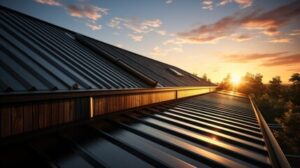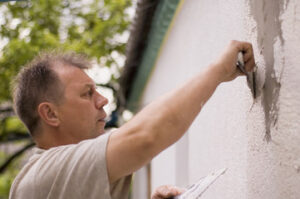Limiting roof traffic is the easiest way to protect shingles. Avoid letting people walk on your roof and make sure that only people servicing equipment have access.

Examine chimneys, vent pipes, skylights, and other roof penetrations for deteriorated caulking or sealant and signs of water intrusion. Keep these areas clean and free of debris to reduce the risk of fires or carbon monoxide leaks. Contact Arthur’s Roofing for professional help.
Flashing is a thin, sturdy piece of metal that protects vulnerable areas on a roof from leaks. It’s placed under shingles or over roof panels and creates a waterproof seal at joints and seams. The best way to prevent flashing problems is by conducting a thorough inspection on a regular basis. Identifying flashing issues early on can help mitigate the need for costly repairs.
During the inspection, homeowners should look for holes, cracks, and gaps in the flashing. These can be caused by bad installation, poor weather conditions, or general wear and tear over time. Left unchecked, these weaknesses can lead to serious water leaks and damage. In addition to checking for these issues, homeowners should also look for rust and other signs of corrosion on the flashing. These signs of corrosion can indicate that the flashing is beginning to deteriorate and will need to be replaced soon.
Inspecting the flashing should include a careful examination of the areas around chimneys, vent pipes, skylights, and other penetrations on the roof. Checking the integrity of the caulk around these areas is also crucial. Look for any areas where the caulk is starting to lift up or crack, and make note of any areas where there are no caulk at all. These areas may be vulnerable to water leaks in heavy rainstorms.
Lastly, inspect the flashing for any sections that appear bent or warped. These areas may be indicative of poor installation, or they could indicate that the flashing is in need of replacement. If these sections of flashing are not repaired or replaced quickly, moisture intrusion will begin to cause problems in the underlying roofing materials. During the inspection, it is also important to remove any debris that has accumulated on or near the flashing, as this can trap moisture against the roof and surrounding shingles. This moisture will eventually cause the shingles to rot and allow water into the home. These types of problems can be prevented by performing a thorough roof maintenance inspection on a regular basis and following the advice provided in this blog post.
Inspect the Attic
The attic of a roof is an important part of the home. It provides vital insulation and ventilation, but it is also a source of problems like moisture accumulation and mold growth that can cause significant damage to the rest of the house. A thorough attic inspection by a professional will help prevent these problems.
During an attic inspection, a professional will examine the insulation in the attic and ensure that it is sufficient to prevent moisture and cold air from entering the living space below. They will also look for any areas where the attic is not properly ventilated, and they may recommend improvements to the ventilation system.
Home inspectors also check the rafters and trusses in the attic to make sure they are intact and free of any rot or other forms of structural damage that could compromise the integrity of the roof. They also look for wires that are spliced together and not in covered junction boxes, since spliced wires can easily spark and cause a fire.
Moisture accumulation in the attic can cause a variety of serious issues, including mold and mildew growth that can affect the entire house. Routine maintenance and regular attic inspections can identify and address moisture issues early, saving homeowners thousands in mold remediation costs.
In addition, the attic inspection should include a review of the sheathing, which is a layer of wood boards that are fixed to the joists and trusses of the roof and add support. The inspector should check for signs of water damage, which are often indicated by stains and black mold. They should also look for mice droppings, which are indicative of rodent infestation. The attic inspection should also involve a thorough examination of the venting systems, ensuring that the soffit, ridge, and gable vents are not blocked by insulation or other objects and that they have not deteriorated over time.
If the home inspector encounters any issues that are not immediately apparent from a visual inspection of the attic, they should use a thermal imaging device to locate any temperature discrepancies in the attic insulation. This can be particularly helpful in identifying gaps in insulation, which are difficult to detect visually and can lead to high energy bills and uncomfortable indoor temperatures.
Clean the Gutters
Gutters, those quiet protectors nestled along the edges of your roof, diligently direct rainwater away from your house and foundation. However, gutters can easily become clogged with leaves and debris, which is why cleaning them is essential to prevent roof damage. Clogged gutters may overflow, causing water to pool on the roof, which can lead to mold growth and wood rot or to drip down and flood the basement. Gutters should be cleaned out at least twice a year, and the best way to do so is by using a pressure washer with a specialized nozzle for removing accumulated dirt and debris from eaves and gutters.
If you have a lot of trees in your yard, the overhanging branches might drop leaves and other debris into your gutters, which can cause clogs. You can minimize the amount of debris in your gutters by trimming overhanging tree branches regularly. In addition, you should also regularly check your gutter seams for signs of wear and tear. If you notice any rust or separation, consider having them professionally repaired.
Another easy way to keep your gutters clean is by using a telescoping ladder fitted with stabilizer arms, which can be purchased at most online retailers and hardware stores. These tools allow you to reach higher places without having to use a ladder that could tip over, putting you in danger.
Alternatively, you can buy a wet/dry vacuum with an extender hose that allows you to suction debris from your gutters from the ground without requiring you to climb a ladder. Gutter guards are another option that can help you avoid the hassle and expense of clogged gutters by allowing only rainwater to enter the system while keeping out leaves and other debris.
While climbing on a ladder to clean the gutters isn’t ideal, it is necessary for proper maintenance. Inspecting the gutters for any signs of rust or separation and clearing them regularly will ensure that they are ready to protect your home from damage during the next storm. You should also make sure that your downspouts are properly positioned, directing water at least five feet away from your foundation to prevent soil erosion and potential basement flooding.
Trim Trees
Trees can add beauty and value to your home’s exterior. They can also provide shade to your yard, help your lawn thrive, and protect your house from storm damage. However, tree limbs can damage your roof and cause costly repairs if they aren’t trimmed regularly. Tree branches can scrape against your roof’s surface, leaving shingle dents and exposing the underlayment. They can also poke into your windows and cause cracks. Then there are the limbs that hang over your house, which can break or fall in high winds. A fallen branch can puncture or tear your siding, break windows and doors, or even cause structural damage to the house.
The best way to avoid these issues is by keeping tree limbs a safe distance from your roof. This can be a challenging task if the trees are tall or close to your house, so it’s often better to hire a certified arborist to handle it for you. They are trained to know how far away to trim a tree from a home and what kind of cuts will promote healthy growth.
A professional will know how to safely cut high branches with a pole pruner rather than climbing or using a ladder. If a branch has a small bud, make your first cut about a foot away from the branch collar (the area where it connects to the trunk). Then move about an inch further out on the limb and make another cut. This should remove the limb without damaging the rest of the tree or causing it to go into shock.
If a tree is unhealthy, it may need to be completely removed. This is a complicated process that requires knowledge of tree anatomy, pruning techniques, and proper safety precautions. It’s also best left to professionals who are insured in the event they damage your roof during a trimming job. A certified arborist can handle these tasks quickly and efficiently, helping you protect your roof from expensive damages. They can also inspect the rest of the tree for signs of disease or other problems.
